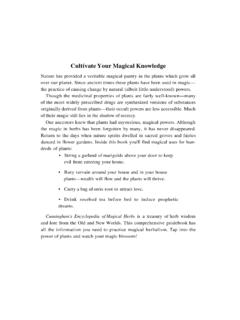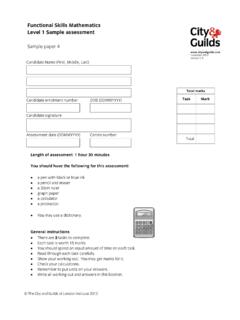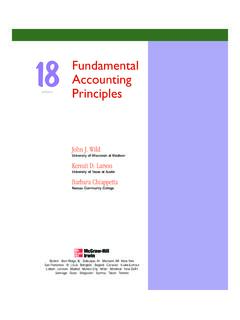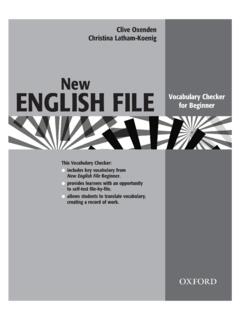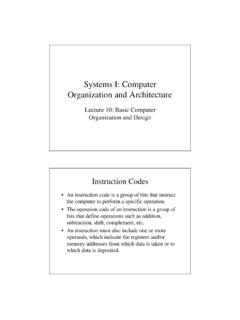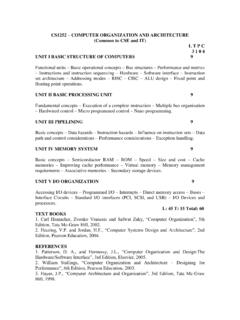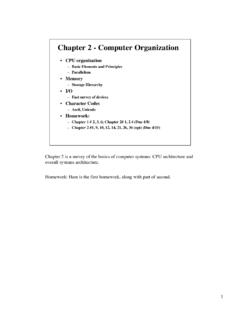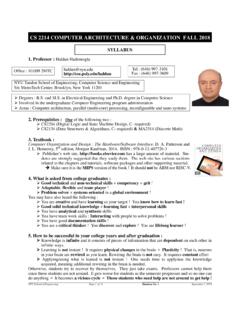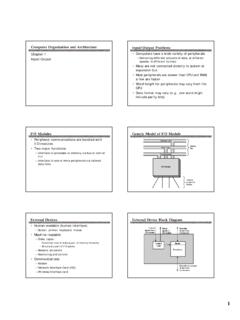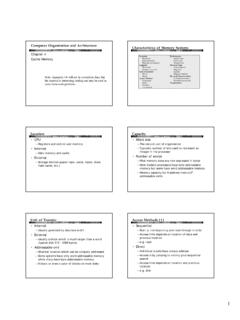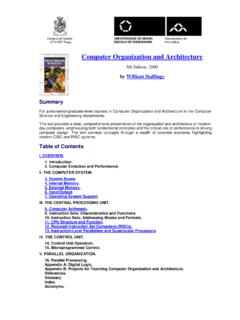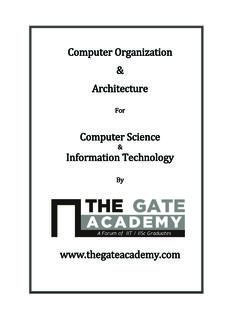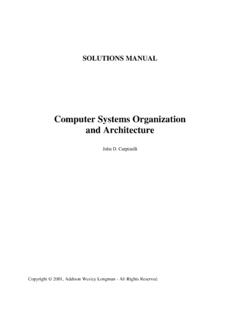Transcription of OLUTIONS M S ANUAL - memberfiles.freewebs.com
1 SOLUTIONS MANUAL computer organization AND architecture DESIGNING FOR PERFORMANCE EIGHTH EDITION WILLIAM STALLINGS -4- Chapter 1 Chapter 2 computer Evolution and Chapter 3 computer Function and Chapter 4 Cache Chapter 5 Internal Chapter 6 External Chapter 7 Chapter 8 Operating System Chapter 9 computer Chapter 10 Instruction Sets: Characteristics and Chapter 11 Instruction Sets: Addressing Modes and Chapter 12 Processor Structure and Chapter 13 Reduced Instruction Set Chapter 14 Instruction-Level Parallelism and Superscalar Chapter 15 Control Unit Chapter 16 Microprogrammed Chapter 17 Parallel Chapter 18 Multicore Chapter 19 Number Chapter 20 Digital Chapter 21 The IA-64 Appendix B Assembly Language and Related TABLE OF CONTENTS -5- CHAPTER 1 INTRODUCTION AANSWERS TO NSWERS TO QQUESTIONSUESTIONS computer architecture refers to those attributes of a system visible to a programmer or, put another way, those attributes that have a direct impact on the logical execution of a program.
2 computer organization refers to the operational units and their interconnections that realize the architectural specifications. Examples of architectural attributes include the instruction set, the number of bits used to represent various data types ( , numbers, characters), I/O mechanisms, and techniques for addressing memory. Organizational attributes include those hardware details transparent to the programmer, such as control signals; interfaces between the computer and peripherals; and the memory technology used. computer structure refers to the way in which the components of a computer are interrelated. computer function refers to the operation of each individual component as part of the structure. Data processing; data storage; data movement; and control. Central processing unit (CPU): Controls the operation of the computer and performs its data processing functions; often simply referred to as processor. Main memory: Stores data. I/O: Moves data between the computer and its external environment.
3 System interconnection: Some mechanism that provides for communication among CPU, main memory, and I/O. A common example of system interconnection is by means of a system bus, consisting of a number of conducting wires to which all the other components attach. Control unit: Controls the operation of the CPU and hence the computer Arithmetic and logic unit (ALU): Performs the computer s data processing functions Registers: Provides storage internal to the CPU CPU interconnection: Some mechanism that provides for communication among the control unit, ALU, and registers -6- CHAPTER 2 computer EVOLUTION AND PERFORMANCE AANSWERS TO NSWERS TO QQUESTIONSUESTIONS In a stored program computer , programs are represented in a form suitable for storing in memory alongside the data. The computer gets its instructions by reading them from memory, and a program can be set or altered by setting the values of a portion of memory. A main memory, which stores both data and instructions: an arithmetic and logic unit (ALU) capable of operating on binary data; a control unit, which interprets the instructions in memory and causes them to be executed; and input and output (I/O) equipment operated by the control unit.
4 Gates, memory cells, and interconnections among gates and memory cells. Moore observed that the number of transistors that could be put on a single chip was doubling every year and correctly predicted that this pace would continue into the near future. Similar or identical instruction set: In many cases, the same set of machine instructions is supported on all members of the family. Thus, a program that executes on one machine will also execute on any other. Similar or identical operating system: The same basic operating system is available for all family members. Increasing speed: The rate of instruction execution increases in going from lower to higher family members. Increasing Number of I/O ports: In going from lower to higher family members. Increasing memory size: In going from lower to higher family members. Increasing cost: In going from lower to higher family members. In a microprocessor, all of the components of the CPU are on a single chip.
5 AANSWERS TO NSWERS TO PPROBLEMSROBLEMS This program is developed in [HAYE98]. The vectors A, B, and C are each stored in 1,000 contiguous locations in memory, beginning at locations 1001, 2001, and 3001, respectively. The program begins with the left half of location 3. A counting variable N is set to 999 and decremented after each step until it reaches 1. Thus, the vectors are processed from high location to low location. -7- Location Instruction Comments 0 999 Constant (count N) 1 1 Constant 2 1000 Constant 3L LOAD M(2000) Transfer A(I) to AC 3R ADD M(3000) Compute A(I) + B(I) 4L STOR M(4000) Transfer sum to C(I) 4R LOAD M(0) Load count N 5L SUB M(1) Decrement N by 1 5R JUMP+ M(6, 20:39) Test N and branch to 6R if nonnegative 6L JUMP M(6, 0:19) Halt 6R STOR M(0) Update N 7L ADD M(1) Increment AC by 1 7R ADD M(2) 8L STOR M(3, 8:19) Modify address in 3L 8R ADD M(2) 9L STOR M(3, 28:39) Modify address in 3R 9R ADD M(2) 10L STOR M(4, 8:19) Modify address in 4L 10R JUMP M(3, 0:19) Branch to 3L a.
6 Opcode Operand 00000001 000000000010 b. First, the CPU must make access memory to fetch the instruction. The instruction contains the address of the data we want to load. During the execute phase accesses memory to load the data value located at that address for a total of two trips to memory. To read a value from memory, the CPU puts the address of the value it wants into the MAR. The CPU then asserts the Read control line to memory and places the address on the address bus. Memory places the contents of the memory location passed on the data bus. This data is then transferred to the MBR. To write a value to memory, the CPU puts the address of the value it wants to write into the MAR. The CPU also places the data it wants to write into the MBR. The CPU then asserts the Write control line to memory and places the address on the address bus and the data on the data bus. Memory transfers the data on the data bus into the corresponding memory location.
7 -8- Address Contents 08A 08B 08C 08D LOAD M(0FA) STOR M(0FB) LOAD M(0FA) JUMP +M(08D) LOAD M(0FA) STOR M(0FB) This program will store the absolute value of content at memory location 0FA into memory location 0FB. All data paths to/from MBR are 40 bits. All data paths to/from MAR are 12 bits. Paths to/from AC are 40 bits. Paths to/from MQ are 40 bits. The purpose is to increase performance. When an address is presented to a memory module, there is some time delay before the read or write operation can be performed. While this is happening, an address can be presented to the other module. For a series of requests for successive words, the maximum rate is doubled. The discrepancy can be explained by noting that other system components aside from clock speed make a big difference in overall system speed. In particular, memory systems and advances in I/O processing contribute to the performance ratio. A system is only as fast as its slowest link.
8 In recent years, the bottlenecks have been the performance of memory modules and bus speed. As noted in the answer to Problem , even though the Intel machine may have a faster clock speed ( GHz vs. GHz), that does not necessarily mean the system will perform faster. Different systems are not comparable on clock speed. Other factors such as the system components (memory, buses, architecture ) and the instruction sets must also be taken into account. A more accurate measure is to run both systems on a benchmark. Benchmark programs exist for certain tasks, such as running office applications, performing floating-point operations, graphics operations, and so on. The systems can be compared to each other on how long they take to complete these tasks. According to Apple computer , the G4 is comparable or better than a higher-clock speed Pentium on many benchmarks. This representation is wasteful because to represent a single decimal digit from 0 through 9 we need to have ten tubes.
9 If we could have an arbitrary number of these tubes ON at the same time, then those same tubes could be treated as binary bits. With ten bits, we can represent 210 patterns, or 1024 patterns. For integers, these patterns could be used to represent the numbers from 0 through 1023. CPI = ; MIPS rate = ; Execution time = ns. Source: [HWAN93] -9- a. CPIA=CPIi Ii Ic=8 1+4 3+2 4+4 3() 1068+4+2+4() 106 106=200 106=90 CPUA=Ic CPIAf=18 106 106= sCPIB=CPIi Ii Ic=10 1+8 2+2 4+4 3() 10610+8+2+4() 106 106=200 106=104 CPUB=Ic CPIBf=24 106 106= s b. Although machine B has a higher MIPS than machine A, it requires a longer CPU time to execute the same set of benchmark programs. a. We can express the MIPs rate as: [(MIPS rate)/106] = Ic/T. So that: Ic = T [(MIPS rate)/106]. The ratio of the instruction count of the RS/6000 to the VAX is [x 18]/[12x 1] = b. For the Vax, CPI = (5 MHz)/(1 MIPS) = 5. For the RS/6000, CPI = 25/18 = From Equation ( ), MIPS = Ic/(T 106) = 100/T.
10 The MIPS values are: computer A computer B computer C Program 1 100 10 5 Program 2 1 5 Program 3 2 Program 4 1 1 Arithmetic mean Rank Harmonic mean Rank computer A 1 2 computer B 3 3 computer C 2 1 -10- a. Normalized to R: Processor Benchmark R M Z E F H I K Arithmetic mean b. Normalized to M: Processor Benchmark R M Z E F H I K Arithmetic mean c. Recall that the larger the ratio, the higher the speed. Based on (a) R is the slowest machine, by a significant amount. Based on (b), M is the slowest machine, by a modest amount. d. Normalized to R: Processor Benchmark R M Z E F H I K Geometric mean -11- Normalized to M: Processor Benchmark R M Z E F H I K Geometric mean Using the geometric mean, R is the slowest no matter which machine is used for normalization. a.
